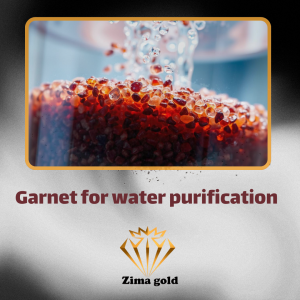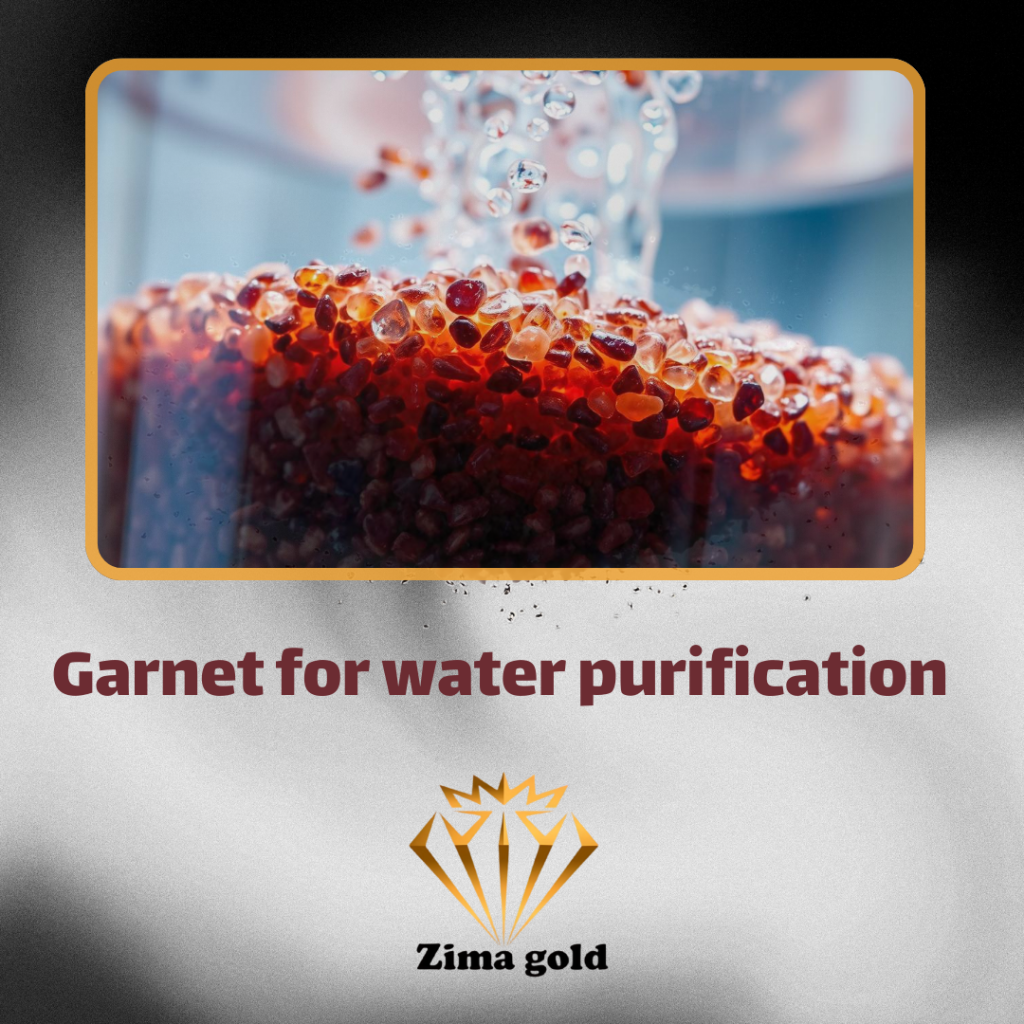Garnet Water Treatment
Garnet filters are among the most important tools used in water treatment. This natural mineral, with its unique chemical structure, effectively removes impurities and contaminants from water. In this article, we will examine garnet, its benefits, the various types, and important tips for purchasing and maintaining it.
Key Points
- This stone is used as a natural mineral filter in water treatment.
- this stone possesses unique physical and chemical properties that enhance its effectiveness.
- There are different types of garnet, including natural and synthetic, each with distinct characteristics.
- Garnet has significant advantages over other filtration media.
- Proper maintenance and cleaning of garnet affect its lifespan and efficiency.

Introduction to Garnet and Its Importance in Water Treatment
Garnet is a mineral with a unique chemical structure. This mineral exhibits extraordinary physical properties, such as hardness and porosity. These characteristics make this stone a highly efficient filtration medium used in water treatment systems.
Chemical Structure of Garnet
Garnet is a silicate mineral with the chemical formula X3Y2(SiO4)3, where elements X and Y can be replaced by various elements. This allows for the formation of different types of this stone, each with unique properties.
Physical Properties of Garnet
One of the most significant features of this stone is its high hardness, which makes it resistant to wear and tear, resulting in a longer lifespan. Additionally, the appropriate porosity of garnet facilitates easy water flow while effectively trapping contaminant particles.
Benefits of Using Garnet in Water Treatment
This stone is highly beneficial in water treatment systems. It efficiently removes impurities, reduces water turbidity, and enhances water quality. Another advantage of this stone is that it prolongs filter longevity, as it is incredibly durable, extending the time between replacements.
| Feature | Garnet | Silica | Anthracite |
|---|---|---|---|
| Removal of Impurities | High | Medium | Low |
| Turbidity Reduction | High | Low | Medium |
| Filter Longevity | High | Low | Low |
Using this stone in water treatment offers numerous advantages, including reduced maintenance costs and increased treatment efficiency.
Types of Garnet Used in Water Treatment
this stone is essential in the water treatment industry, and it can be categorized into different types. In this section, we will review the types of garnet and their differences.
Natural Garnet
This stone is a silicate mineral found in nature. Types like Almandine and Pyrope garnet differ in their chemical and physical properties.
Synthetic Garnet
In contrast to natural garnet, synthetic garnet is created in laboratories through chemical processes. Synthetic garnet typically has higher purity and uniformity.
Quality Differences Among Types of Garnet
Both natural and synthetic garnets have specific advantages.
- Almandine garnet is suitable for water treatment due to its high hardness.
- Pyrope garnet has higher density and helps regulate water flow.
| Feature | Almandine Garnet | Pyrope Garnet | Synthetic Garnet |
|---|---|---|---|
| Hardness | High | Medium | High |
| Density | Medium | High | Medium |
| Purity | Medium | Medium | High |
| Treatment Performance | Good | Excellent | Excellent |
| Lifespan | Medium | Medium | High |
Price and Purchase of Garnet for Water Treatment
- Quality and Type of Garnet: Higher purity garnet usually comes at a higher price.
- Quantity Purchased: Bulk buying often comes with discounts.
- Sales Location: Prices may vary depending on stores or suppliers.
How Garnet Works in Water Treatment Systems
Garnet functions through physical filtration and surface adsorption, efficiently removing impurities and suspended particles from water.
In physical filtration, larger particles that exceed the size of garnet’s pores are separated from the water. Surface adsorption allows garnet to remove heavy metals and organic materials from water.
| Feature | Description |
|---|---|
| Physical Filtration | Removes larger suspended particles using garnet pores |
| Surface Adsorption | Eliminates heavy metals, organic materials, and other dissolved contaminants |
By combining these two mechanisms, garnet effectively removes a wide range of water contaminants, making it a recognized efficient filtration medium.
Comparing Garnet with Other Filtration Media
In this section, we will compare garnet’s performance with that of silica and anthracite. Each of these materials has its pros and cons, helping you choose the best option for water treatment.
Garnet vs. Silica
Silica is a common filtration medium, known for its cost-effectiveness and easy availability. However, garnet performs better in removing contaminants. Garnet also has a higher ion-exchange capacity, which translates to a longer lifespan compared to silica.
Garnet vs. Anthracite
Anthracite is also used for water treatment, but garnet has a higher adsorption power in removing organic matter. Moreover, garnet exhibits greater resistance to breakage.
| Feature | Garnet | Silica | Anthracite |
|---|---|---|---|
| Contaminant Removal Power | High | Medium | Medium |
| Ion-Exchange Capacity | High | Low | Low |
| Breakage Resistance | High | Medium | Low |
| Lifespan | High | Medium | Medium |
Garnet surpasses both sand and carbon filters due to these qualities, making it a suitable option for water treatment.
Guide to Buying Garnet for Water Treatment
Selecting the right garnet for a water treatment system is crucial. Choosing the appropriate garnet can significantly affect the system’s performance. This article will discuss important factors regarding the price and quality of garnet.
The first step is to consider the physical and chemical properties of garnet, such as hardness, wear resistance, and chemical stability. Additionally, the origin of the garnet should be noted.
- Examine technical specifications of garnet, including grain size, hardness, erosion resistance, and chemical stability.
- Consider the source of garnet (natural or synthetic) and compare their quality.
- Compare garnet prices across different sources to choose the best option.
- Review brands and the seller’s reputation to ensure the quality of garnet.
By adhering to these guidelines, you can select high-quality garnet, ensuring optimal performance of your water treatment system.
Maintenance and Proper Washing of Garnet
To maintain efficiency and increase the lifespan of garnet in water treatment systems, proper maintenance and cleaning are essential. Regular cleaning of the garnet filter should be performed using appropriate methods. This not only preserves the filter’s effectiveness but also enhances the longevity of garnet.
Replacement Timing for Garnet
The suitable time to replace garnet depends on several factors, including water consumption, incoming water quality, operational flow rate, and the extent of backwashing performed. Generally, garnets should be replaced every 3 to 5 years to prevent a decline in filter efficiency.
Reverse Washing Methods
- Periodic reverse washing (backwashing) using counterflow water cleans and revitalizes the garnet.
- Backwashing must be conducted regularly (at least once a week) to prevent particle accumulation in the garnet.
- The best time to perform backwashing is when pressure drop across the garnet reaches a specified level.
By adhering to these guidelines and practicing proper maintenance and washing, you can significantly enhance the lifespan and performance of water treatment garnets.
Industrial Applications of Garnet in Water Treatment
Garnet finds applications in various industries, especially in industrial water treatment, where it plays an important role in removing contaminants from industrial wastewater. It is also used in the treatment of drinking water, as its physical and chemical properties help remove color, taste, odor, and suspended particles. These characteristics make it a widely used material in water treatment.
Garnet has considerable capabilities for contaminant removal, which is utilized across various sectors, including food, pharmaceuticals, oil and gas, and chemicals.
Unique Features of Garnet
Garnet is a natural mineral filter with specific attributes that make it suitable for water treatment. These features include high hardness, appropriate porosity, and effective impurity removal.
Benefits of Using Garnet in Water Treatment
This stone offers numerous advantages in water treatment, including its ability to remove impurities, reduce water turbidity, prolong filter lifespan, and improve the quality of treated water.
Types of Garnet for Water Treatment
Garnet can be divided into two categories: natural and synthetic. Both types possess specific characteristics essential for selecting the appropriate garnet for water treatment.
How Garnet Operates in Water Treatment Systems
Garnet acts through physical filtration and surface adsorption, effectively removing suspended particles and certain heavy metals from water, thus enhancing the quality of the treated water.
Comparison of Garnet with Other Filtration Media
Garnet offers advantages such as better impurity removal and increased filter longevity compared to other filtration media, making garnet a more desirable choice for water treatment.
Purchase Considerations for Garnet Water Treatment
When purchasing garnet, it is vital to consider quality, origin, grain size, and price. Recognizing reputable sources for obtaining garnet with desirable characteristics is also important.
Maintenance and Cleaning of Garnet
Proper maintenance and cleaning of garnet are critical for ensuring optimal performance and longevity of the filter, paying attention to the appropriate replacement time and effective reverse washing methods.
Industrial Uses of Garnet in Water Treatment
this stone is employed across diverse industrial applications, including industrial wastewater treatment and drinking water purification, with its unique properties making it an essential material in numerous industrial uses.

